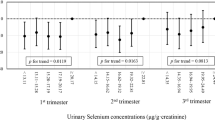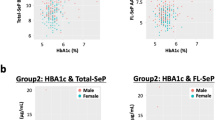Abstract
Summary: Paired samples of maternal and cord plasma and erythrocytes, as well as samples from nonpregnant adult females, were assayed for selenium and for glutathione peroxidase (GSH-Per) activity. Fetal selenium levels, both in red cells (0.39 ± 0.08 μg/ml) and in plasma (0.13 ± 0.03 μg/ml), were significantly lower than the respective levels in either pregnant (P < 0.001) or nonpregnant (P < 0.001) female adults. GSH-Per activity in fetal red cells (576 ± 131 U/100 ml) and plasma (10.3 ± 4.0 U/100 ml) were similarly significantly lower than the respective levels of activity in each group of adult samples (P < 0.001). Erythrocyte selenium levels were similar in nonpregnant (0.52 ± 0.05 μg/ml) and pregnant (0.52 ± 0.07 μg/ml) adult females; but there was a significant difference in erythrocyte GSH-Per activity between the nonpregnant (832 ± 165 U/100 ml) and the pregnant (990 ± 207 U/100 ml) groups (0.02 < P < 0.03). The plasma levels of selenium in the nonpregnant females (0.21 ± 0.03 μg/ml) were significantly higher than in the pregnant group (0.19 ± 0.03 μg/ml) (0.01 < P < 0.02); similarly, plasma enzyme activity in the nonpregnant group (19.5 ± 4.4 U/100 ml) was significantly higher than in the pregnant group (14.0 ± 3.2 U/100 ml) (P < 0.001). A close positive correlation was found between selenium levels and GSH-Per activity, both in plasma and in red cells (r = 0.86). The mothers' values for enzyme activity and for selenium, both in plasma and in erythrocytes, were almost invariably higher than the comparable values in her own fetus.
Speculation: Selenium has a biologic role as a component of GSH-Per. Low activity of this enzyme in the fetus is probably an adaptation to a low requirement for antioxidant protection. After birth the continuation of the intrauterine developmental phase may contribute in part to the increased oxidant sensitivity of neonatal red cells. Prolonged inadequate dietary intake of selenium, especially in small premature infants, may further increase sensitivity to oxidant stress.
Similar content being viewed by others
Log in or create a free account to read this content
Gain free access to this article, as well as selected content from this journal and more on nature.com
or
Author information
Authors and Affiliations
Rights and permissions
About this article
Cite this article
Rudolph, N., Wong, S. Selenium and Glutathione Peroxidase Activity in Maternal and Cord Plasma and Red Cells. Pediatr Res 12, 789–792 (1978). https://doi.org/10.1203/00006450-197807000-00010
Issue date:
DOI: https://doi.org/10.1203/00006450-197807000-00010
Keywords
This article is cited by
-
Attenuating effects of selenium and zinc against hexavalent chromium-induced oxidative stress, hormonal instability, and placenta damage in preimplanted rats
Environmental Science and Pollution Research (2023)
-
Urine Selenium Changes During Pregnancy Do Not Correlate with Thyroid Autoantibodies in a Mildly Iodine Deficient Population
Biological Trace Element Research (2014)
-
Iodine, Selenium, and Other Trace Elements in Urine of Pregnant Women
Biological Trace Element Research (2010)
-
The Interaction Between Selenium Status, Sex Hormones, and Thyroid Metabolism in Adolescent Girls in the Luteal Phase of their Menstrual Cycle
Biological Trace Element Research (2007)
-
Selenium in the neonate
The Indian Journal of Pediatrics (2002)



